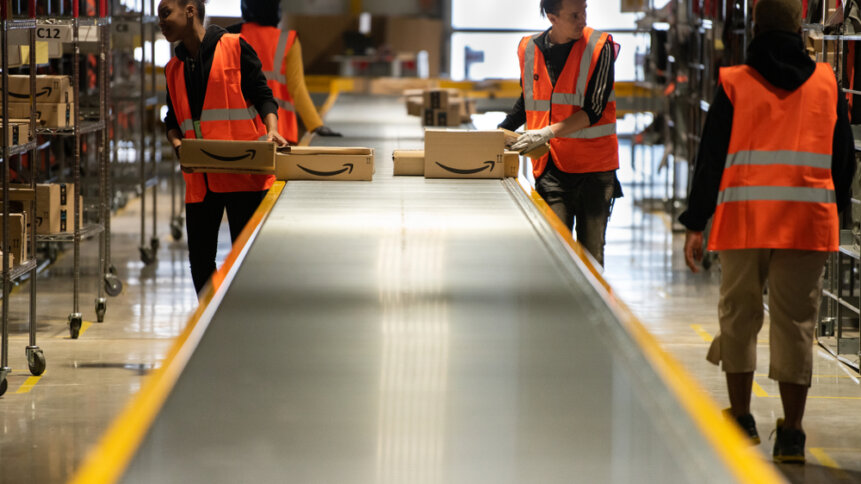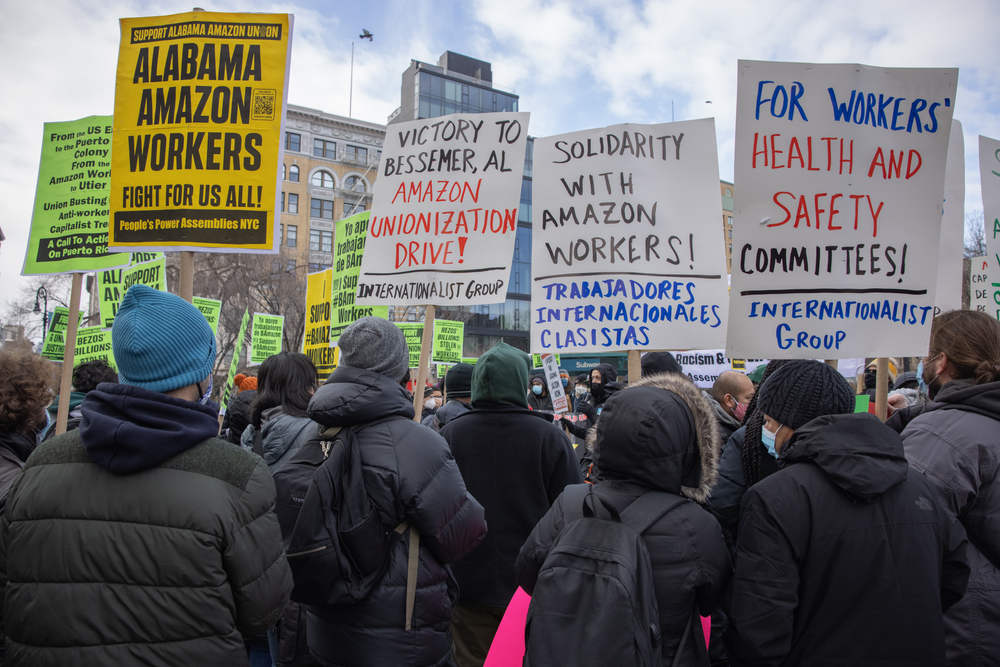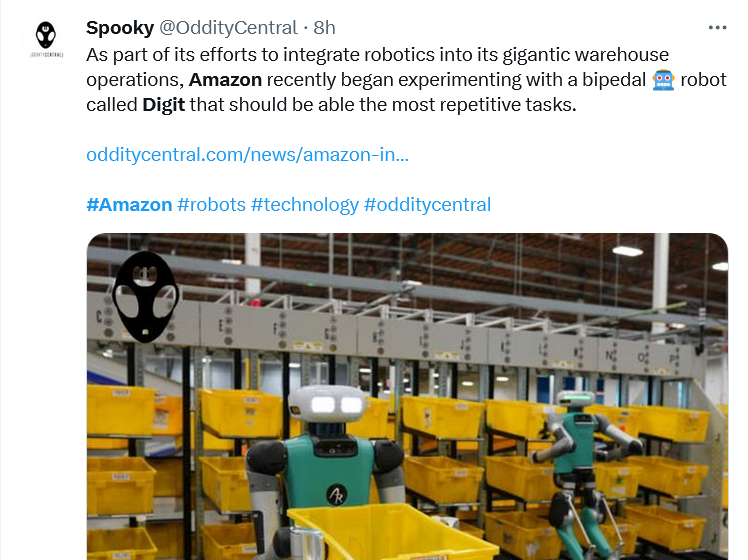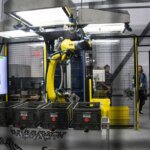Automation on legs: humanoid robots trialled by Amazon in bid to “Free up staff”

• Humanoid robots are being trialled in Amazon warehouses.
• The company has an atrocious record of both employee welfare and anti-unionization policies.
• As such, workers are worried that the humanoid robots will replace them altogether.
Amazon has continued its recent trend of utilizing robotics in its warehouses by introducing humanoid robots on a trial basis to perform some of the more mundane, repetitive tasks warehouse operations involve. According to an Amazon spokesperson, these humanoid robots are “freeing employees up to better deliver for [their] customers.”
Automating operations is nothing new for Amazon. The tech giant has been under pressure to cut costs in recent years, leading to a significant increase in the use of robotics.
For instance, Amazon announced that it was trialling a giant robotic arm in 2022. Its task? To pick up various goods and items and help with tote recycling. Amazon warehouses already employ wheeled robots for warehouse item transport, and the company has initiated drone deliveries in two US states, with the aim of expanding Prime Air, its drone delivery project, to the UK and Italy next year.
The new humanoid robot being tested goes by the name of Digit and is designed with its own pair of hands and legs, rather than wheels. This is just one of 750,000 robots collaborating with human staff across Amazon’s 185 fulfilment centres worldwide. However, the use of automated systems has led to allegations that Amazon may be planning to replace its entire human workforce in time. But, according to one the one trade union that has so far managed to form in a US Amazon facility despite the company’s massively controversial anti-union stance, the company has “been treating their workers like robots for years.”
Amazon’s poor HR history
Amazon has endured a torrid history of lawsuits and allegations associated with hostile work environments and grave HR misconduct. Several testimonials have come to light from former Amazon workers who claimed they were overworked to the point of urinating in water bottles due to time constraints, keeping them from taking real bathroom breaks.
Amazon has also faced severe criticism over internal HR issues, resulting in widespread underpayment of warehouse staff. A New York Times report revealed instances of employees, including vulnerable individuals, being underpaid for over a year due to HR errors. The investigation, triggered by a worker’s complaint, identified over 100 similar cases across various warehouses.
It’s worth remembering that Amazon lives or dies on its logistics performance – and yet the idea remains that these errors persisted for over a year by ongoing accident.
Problems include automated systems (they don’t always work) leading to wrongful terminations, insufficient support for medical issues, and overseas call routing causing communication gaps.
While Amazon has vowed to address such issues by means such as increased hiring, improved communication, and enhanced HR training, many HR issues persist, and the company is still facing legal action from delivery drivers and other workers seeking their rights.
According to numerous reports, Amazon warehouses, particularly those in some US cities, see double the national average of turnover. In light of the HR issues we’ve mentioned, Amazon’s growing reliance on robotics in warehouses may well be linked to this high turnover, with automated systems seemingly contributing to employee dissatisfaction.
Unions voice their concerns
Amazon’s shift toward the use of robots has raised serious concerns from labor unions. They have suggested that such automation has led to a multitude of job losses in the company’s fulfilment centres.
Stuart Richards, a UK trade union representative, said that automation will be responsible for a rapid plunge into job cuts. “We’ve already seen hundreds of jobs disappear in fulfilment centres.”
Amazon has reiterated that its robotic systems have helped generate “hundreds of thousands of new jobs,” including over 700 new job categories requiring “skilled roles.” While Amazon utilizes over 750,000 robotic systems, they are said to work “alongside” humans, rather than “instead” of them.
Scott Dresser, a member of the team at Amazon Robotics, reported that Digit, the new robot, is “an experiment that we’re running to learn a little bit more about how we can use mobile robots and manipulators in our environment here at Amazon.” The prototype is being trialled to see whether it can work safely with human employees to perform highly repetitive tasks.
Mr Dresser emphasised that automation has not been responsible for job losses. He suggested that these fears are unfounded. “Our experience has been that these new technologies actually create jobs, they allow us to grow and expand. And we’ve seen multiple examples of this through the robots that we have today. They don’t always run, unfortunately,” he said, “and we need people to repair them.”
Notably, Mr Dresser pointed to no hard evidence that the technologies created jobs rather than killing them, relying on the vague and godlike “experience” of Amazon to cover his comments with a sheen of legitimacy.
Tye Brady, the chief technologist at Amazon Robotics, stressed that human workers have an irreplaceable role in Amazon’s fulfilment centres. In relation to worries over future Amazon warehouses becoming completely automated, Mr Brady stipulated, “There’s not any part of me that thinks that would ever be a reality. People are so central to the fulfilment process; the ability to think at a higher level, the ability to diagnose problems.”
Nevertheless, the fact that Digit mimics human movements, can grasp items, navigate stairs, steps, and various obstacles indicates an advancement in technology. Therefore, it is no surprise that worries are intensifying regarding potential job displacement and the economic impacts from job losses – particularly in a company with such a lamentable track record in terms of standing by the rights of its human workers.
Sequoia – Amazon’s other new robotic system
In October, Amazon introduced another new robotic system, known as Sequoia. Like Digit, this has been designed to move goods around various warehouses and alter Amazon’s containerized methods.
Currently, large yellow storage racks are used to move various items around in Amazon warehouses. These include cubbies where items can be packed or removed by employees. While a human workforce is required, these racks use autonomous drives that move them along.
Sequoia differs in that it implements storage racks that are filled with blue or yellow totes. The new system uses arms to pick up totes before taking them to an employee’s workstation. As with Digit, Sequoia frees up human resources.
According to Amazon, the primary goal of Sequoia is to improve the safety of its workforce. By delivering items to an employee’s “power zone” (between their mid-thigh and mid-chest region), workers will not have to squat down to pick up goods or reach above their heads, limiting the risk of injuries.

Amazon has a highly contentious record of dealing with human beings.
Over the years, Amazon has come under extreme criticism for the high injury rates within its fulfilment centres. Musculoskeletal injuries, in particular, have been reported several times, typically caused by straining whilst squatting, reaching, pulling, or pushing. In one Washington Amazon warehouse, a third of all workers who suffered from musculoskeletal disorders were off sick for 100 days or more between 2006 and 2018.
With compensation claims rising, Amazon has appealed the citations, but also insists its investment in training and technology has made its warehouses safer.

Humanoid robots working alongside organics at Amazon. Forever, or just for now?
Rain Wang, a senior technical product manager at Amazon Robotics, said, “Amazon Robotics has really pioneered the idea of goods to people. With Sequoia, we’re able to make a functional improvement to employee safety.”
According to Wang, there are no plans for Sequoia to replace every storage rack in Amazon’s facilities. But we are yet to hear what sites are confirmed for the implementation of this new system.
Scott Dresser added that Amazon’s new robotic systems are not associated with the recent rise of regulatory scrutiny. “This is stuff we’ve been working on for way beyond some of the scrutiny we’ve seen recently.”
With a questionable history regarding HR practices, worker safety, and mass layoffs, Amazon’s introduction of automated robotic systems raises deep ethical queries that will continue to rage on for some time to come.











